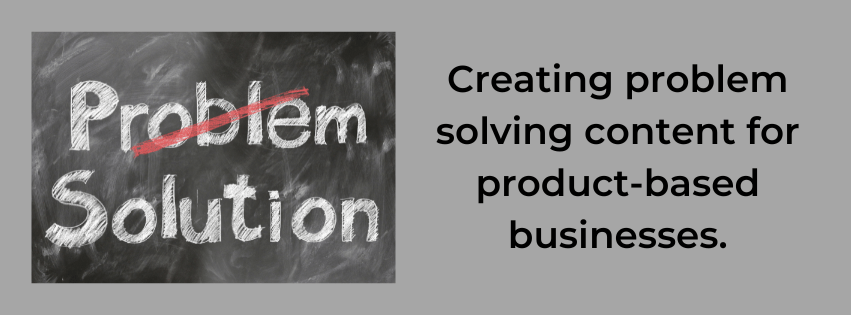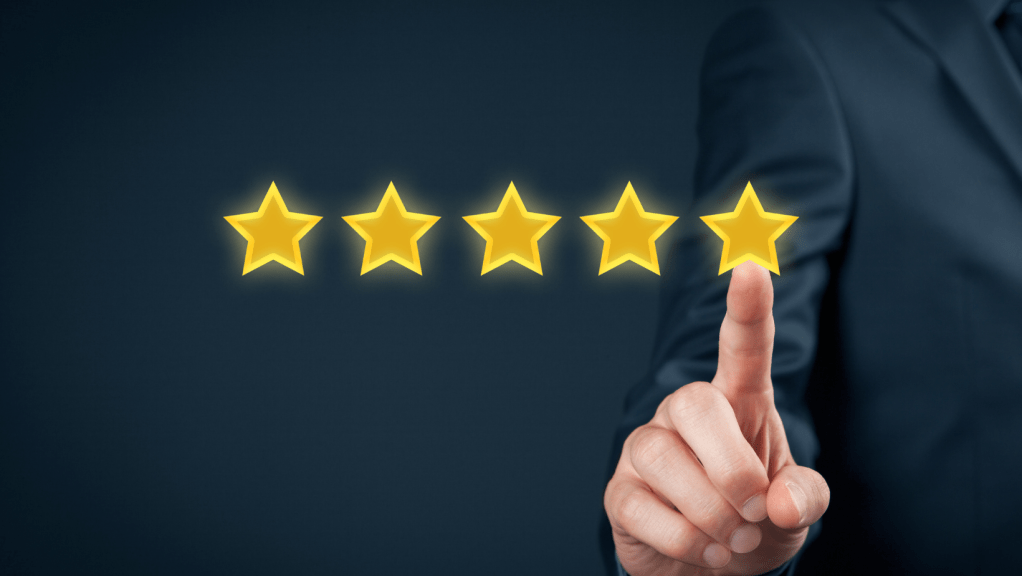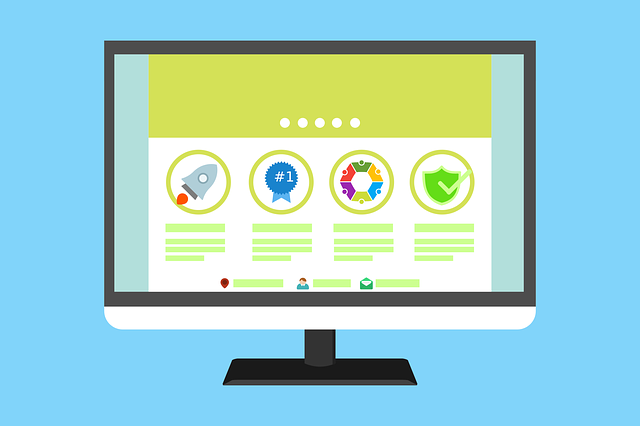Over the past few weeks, I’ve had a lot of people ask about how to create problem solving content. And why would you need to do that, especially if you’re a product-based business? There is a lot of information out there about problem solving for service-based businesses, so this article is for all my product-selling followers! And by writing this and creating social media content around this subject, I’m creating problem solving content!
What is problem solving content and why do you need it?
The first thing I want to say is that you need to address your customers’ problems or pain points, without them feeling you’re giving them the hard sell. This is a real turn-off!
With social media being such a popular medium, it makes sense to have some engaging content that makes them think. Everyone loves to read a story and people love to be able to express their opinions or join in with a debate, so let’s look at how you can address this.
Problem solving content captures your followers’ attention by giving them an answer to a particular question or concern they might have. And provides tangible examples to illustrate your points.
Why do you need it? It helps your customers and potential customers imagine how they can use your product and that it is something they NEED in their life! Being able to picture themselves using your product and the benefits it brings is half the battle to getting a sale.
Understand your audience’s problems.
I know I bang on about this all the time, but the first step to creating the content is understanding what problems your customers may have. This once again boils down to knowing your target audience and what challenges they face, what they might be interested in and any obstacles they might have (or excuses) for not being interested in what you have to offer.
One of the ways to obtain this information is to ask questions or conduct polls on social media, asking for feedback from your audience. For example, you may have a very popular product – ask WHY your customers like this particular product.
And ask what else they would like to see from you.

Give your audience solutions they understand and can relate to.
Once you understand the problems or worries your audience has, it’s time to think of ways to show them the solution – one they will understand and be able to relate to.
Don’t just tell them how to solve a problem, show them. You can use case studies, examples from reviews or recommendations, or an online tutorial or short video to illustrate how your product can solve a problem. This helps make your content interesting, engaging and gives them ideas as to how your products can be used.
Let me give you a few examples for different kinds of products:
You sell jewellery – it’s always exciting to show images and maybe slide shows of your jewellery, but if you have a customer who has bought something from you for a particular occasion, ask them to send you a photo of themselves wearing your jewellery. You can then use their review with a photo – it packs more punch.
Give ideas as to how a particular piece of jewellery could work. You might sell earring and necklace sets that would be perfect for a bride to wear on her wedding day. Photograph those sets with a wedding inspired background – if you use Canva, there are wedding inspired backgrounds you can use. Then, instead of just focusing on the bride, why not show other sets that may be in different colours that could be gifted to bridesmaids? If you do jewellery with different length chains, you can say that in your content.
If you make your own jewellery, show the process in step-by-step photos or be brave and do a time lapse video, stating that you offer a bespoke service for those special pieces or gifts.
You make hair accessories – you can use all the same ideas as for jewellery, but also you can include children in your marketing. Children love hair accessories for many different occasions, such as going to school (could you offer scrunchies or hairbands in school colours for example?), or the same with a bit of bling for parties.
When you are advertising your products, show or give ideas as to how they can be used. If you do adult accessories, (as someone with long hair that gets in my way), you could push the angle of headbands/scrunchies are not only stylish and pretty but keep your hair out of your face when you’re gardening or at the gym.
You sell gift items – this is a broad category. You might sell soft toys, handmade items or personalised items, or a host of other things. But the principle is still the same. Give potential customers ideas on how they can be used and what events they could be used for. This could be birthday’s, Christmas, Easter, Valentine’s Day, Mother’s Day, Father’s Day, birth of a baby, christening, wedding – the list is endless. But if you have products that could be adapted to all these special dates, you have a bigger market for your products.
If you have safety features or must have safety certificates for your products, mention this, so people are happy that a product is safe to gift to children for example.

You sell beauty products, personal products, or home cleaning products – there are lots of ways to show and tell that these products solve problems. For skin products or personal products, it could be that it will make your skin glow, help with skin problems, is an effective deodorant, softens your skin after shaving – the list is endless. The key here is to do videos of you using the products or having lots of before and after photos from customers, or photos of customers using your products. Reviews about how it helped solve a particular beauty or personal problem will also give you social proof that your products work and are worth investing in. Tell customers that they don’t contain any nasty chemicals and if they are allergy friendly.
The same applies to cleaning products – are they eco-friendly and don’t contain harsh chemicals? Do they work? Create videos showing you using the products, for example on a sink – before and after. Use customer reviews to give you social proof.
I could go on with all the different types of business out there, but the principles are the same, no matter what business you are in.
Be honest with your audience.
This goes without saying, but transparency is really important. Be honest about what customers can expect from your products and their solutions. Don’t promise something you can’t deliver or you’re not sure is correct.
Always set realistic expectations.
Engage with your audience.
This is more important than a lot of people realise. Talk to your audience. When they make a comment on your post, always reply to it and if necessary ask questions and engage in a conversation. If someone asks a specific question, answer it or if you think it might be more personal, reply that you will send them a private message – and ensure that you do!
Ask for feedback on your products, your content, your videos and ask if there is anything else your audience would like to see.

Do you write a blog or have your own newsletter?
If you write a blog, you can use it to go into more detail about a particular product. A post on social media shouldn’t be too long or people won’t read it, but if they read your blog or have signed up to your newsletter, you have a captive audience, who WANT to know more or find out more about you and your business, including your products.
So, if you create a post that you could give a lot more detail about, write a blog post about it and advertise that on your social media account. And if you have a newsletter, include a paragraph every time about one of your products and how it solves a problem. Again, you can advertise this on your social media posts. This not only offers a more in-depth service, but it also directs traffic to your website or blog.
Final thoughts
You need to know your target audience and what they want. You must understand what kind of problems they have that your products can solve.
If you feel you are struggling with how to create problem solving content for your business, I can help. Sometimes it’s a case of ‘two heads are better than one.’ I offer an hour’s brainstorming session, where we can discuss your business, find out more about your target audience and set a plan in place to create that problem solving content that will speak to your customers and ultimately get more sales. Either message me or drop me an email to make an appointment – cindymobey@outlook.com
Now, put your thinking cap on and get creative!





















 comments and respond to any reviews you get. You can also connect with influencers related to your content – like and share their content, make comments on their pages. If you belong to groups relating to your niche, take part in conversations, give advice, answer questions – interact with people. Your responses and interaction help social media algorithms recognise that your content is active, which in turn, improves its reach. And KEEP POSTING – social media moves very quickly and it’s easy for posts to get lost among all the others.
comments and respond to any reviews you get. You can also connect with influencers related to your content – like and share their content, make comments on their pages. If you belong to groups relating to your niche, take part in conversations, give advice, answer questions – interact with people. Your responses and interaction help social media algorithms recognise that your content is active, which in turn, improves its reach. And KEEP POSTING – social media moves very quickly and it’s easy for posts to get lost among all the others.




 The main reason is so that your business is showing up where your potential customers are….i.e. online! If someone is searching the internet for something that you sell, at some point they will come across your website. A website is like your shop front…but it is open 24 hours a day, 7 days a week. It sells your products or services even when you’re asleep, on holiday or otherwise engaged. So you could be missing out on potential business if you don’t have one. And with loads of different website-building platforms to choose from, that have online tutorials and community based support, it’s a fairly easy process.
The main reason is so that your business is showing up where your potential customers are….i.e. online! If someone is searching the internet for something that you sell, at some point they will come across your website. A website is like your shop front…but it is open 24 hours a day, 7 days a week. It sells your products or services even when you’re asleep, on holiday or otherwise engaged. So you could be missing out on potential business if you don’t have one. And with loads of different website-building platforms to choose from, that have online tutorials and community based support, it’s a fairly easy process.
 seven days a week. If you combine your website with a blog or newsletter, your customers can see when you have special offers and new products.
seven days a week. If you combine your website with a blog or newsletter, your customers can see when you have special offers and new products. It’s very important to first of all choose the right domain name for your website because you will hopefully have it for a long time and it becomes part of your branding. You might want to have a domain that is your name.
It’s very important to first of all choose the right domain name for your website because you will hopefully have it for a long time and it becomes part of your branding. You might want to have a domain that is your name. important to do just that. If they can’t find what they want on your site, they can click away and choose someone else.
important to do just that. If they can’t find what they want on your site, they can click away and choose someone else.
 Search engines, such as Google, are what brings traffic to your website, so you need to ‘optimize’ your site. It’s important to add keywords or phrases in your headings, text, URL and Meta descriptions. For more information on SEO, click here.
Search engines, such as Google, are what brings traffic to your website, so you need to ‘optimize’ your site. It’s important to add keywords or phrases in your headings, text, URL and Meta descriptions. For more information on SEO, click here. what your competitors do…you can then get an idea of what you’d like your site to look like. If you have a logo, the colours, font and style of your logo will determine the design of your website, so that everything is consistent.
what your competitors do…you can then get an idea of what you’d like your site to look like. If you have a logo, the colours, font and style of your logo will determine the design of your website, so that everything is consistent.










 OK, so you’ve tested whether you can be found, you’ve registered your business to make it easier to be found in search engines. Now you need to look at your website and ensure you have the right keywords and phrases in place.
OK, so you’ve tested whether you can be found, you’ve registered your business to make it easier to be found in search engines. Now you need to look at your website and ensure you have the right keywords and phrases in place.